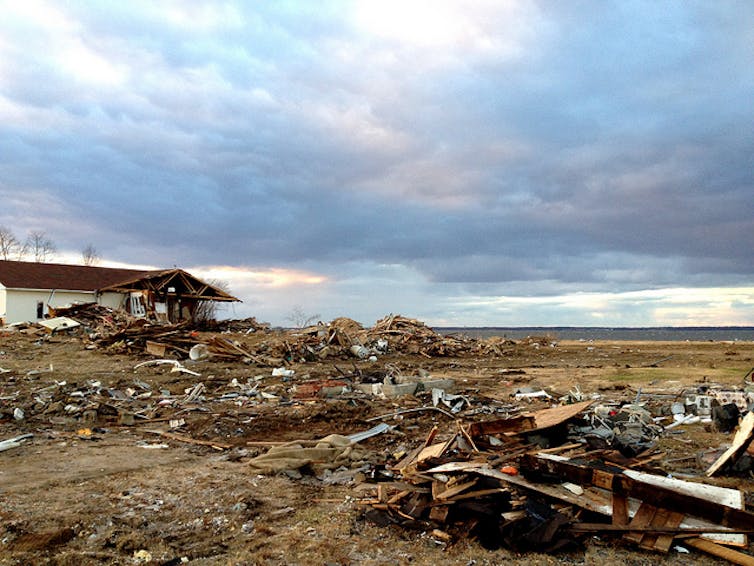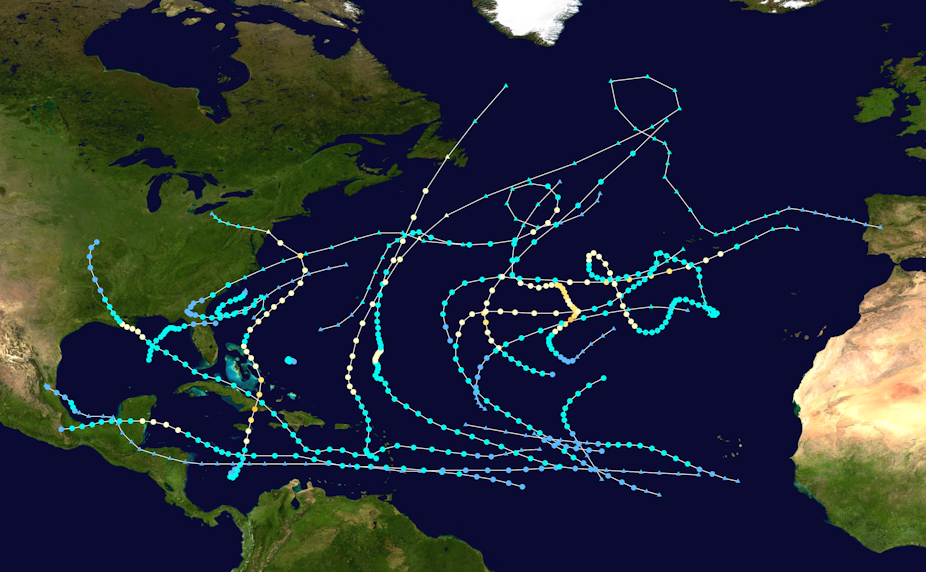Editor’s note: The following is a roundup of archival stories.
While hurricanes can occur at any time of year, they are most frequent in August, September and October – not surprising, since they derive their energy from warm ocean waters.
Be prepared
The best way to stay safe against hurricanes and coastal storms is to invest in hazard-resistant buildings. Using stronger materials and disaster-proof features may cost more, but MIT’s T. Reed Miller argues the investment is worth it:
“Instead of designing a building to reduce potential damage from the hazards it may face over its lifetime, most construction projects focus on saving money up front. By choosing the lowest construction cost possible, homeowners, insurance agencies and taxpayers may end up paying for it many times over when natural disasters occur.”

Georgia State University law professor John Travis Marshall urges public officials to help their towns prepare by identifying laws and policies that could hamper rebuilding after a big storm. In these circumstances, owners need clear title to properties and cities need to know whether they can use tools such as eminent domain to clear damaged areas.
However, Marshal writes,
“many relevant state constitutional provisions, local ordinances and federal laws were adopted before hazard mitigation, climate change and sea level rise were part of politicians’ lexicons. And some newer laws have been conceived narrowly, without considering disaster risk reduction or recovery. These laws can make it hard to restore businesses, families, schools and hospitals after disasters strike.”
Understanding storm forecasts
When a storm is expected to approach the coast, residents in affected zones can tune into updates from the federal government’s National Hurricane Center. These bulletins typically show a “cone of uncertainty” that represents the broad path forecasters expect the storm to follow, with a black line in the center depicting the projected storm track.
Hurricane forecasts are constantly improving: NHC’s “cone of uncertainty” for a typical storm has shrunk roughly 40 percent since 2005. But NHC branch chief James Franklin emphasizes there still is uncertainty in every forecast. That’s especially true for estimating a storm’s intensity – the strength of the highest winds:
“The physics are far more complicated, involving features and processes on the smaller scale of miles or tens of miles, rather than the hundred- or thousand-mile-wide features that govern [a storm’s] track.”

When storm paths diverge from their predicted paths, people may assume that the forecasters got it wrong – ignoring that uncertainty factor. Some have even accused weather agencies of hyping hurricane threats to support a narrative of extreme weather driven by climate change. But retired Rear Admiral and Penn State University meteorology professor David Titley calls such arguments absurd:
“During my career I have seen the internet and social media transform weather forecasting in general, and hurricane forecasting in particular, from a skill that was seen and practiced by a small community of specialists into one of the most transparent technical endeavors we do on a routine basis. Every forecaster I have ever worked with – military or civilian – wants to get predictions right. And even if they wanted to shade the forecast one way or another to support some agenda, it would be impossible to do it in today’s networked world.”
If a storm hits
When a hurricane threatens populated areas, public officials may issue evacuation orders. Often, however, many people choose to stay in place. Texas A&M professor Jennifer Horney has found that many factors influence decisions to stay or go – most importantly, whether people have been through a hurricane before.
Cost can also be a factor, especially for lower-income residents, who are also likely to live in substandard housing and lack reliable transportation. This is especially true in the southeastern United States, she notes:
“Between 2000 and 2012 populations in the southeastern Atlantic and Gulf Coast census regions increased nearly twice as fast as the national average. Along with this growth, the proportion of coastal residents who are socially vulnerable – for example, who are elderly, work in low-wage service industry jobs or belong to racial and ethnic minorities – also rose.”

Disaster evacuations are traumatic for everyone, but especially for children. According to Georgia State University’s Betty Lai, approximately one in seven children in the United States will experience a disaster during their childhood.
Lai found that roughly 70 to 80 percent of children who evacuated during several major hurricanes had recovered from stress, anxiety and depression within a year. If children are struggling after a disaster, she advises, adults can help them learn to identify their fears and find solutions.
The most important thing is to get children back into their routines as soon as possible. Routines are comforting to children, and help them feel like life is “back on track.”

